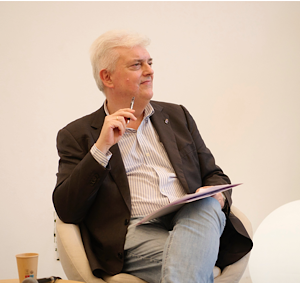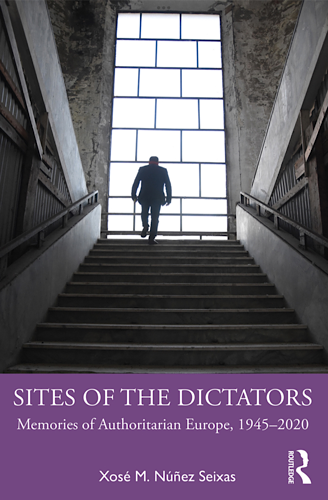From Spain to the Baltic States Europe is littered with sites connected to the personal lives of former dictators. Birthplaces, childhood homes, summer and winter residences, mausoleums and tombs these sites of dictators can be powerful poles of attraction for extremists, nostalgists, and dark tourists. They can also offer opportunities to bolster democratic systems by educating citizens about difficult pasts. How have Europeans taken up the challenge of managing these memory sites? What do these sites reveal about the politics of memory in Europe? These are the questions Spanish historian Xosé Manoel Núñez Seixas takes up in his book Sites of the Dictators: Memories of Authoritarian Europe, 1945-2020.
It was after teaching in Germany for five years and returning his native Galicia in Spain to take a position at the University de Santiago de Compostela that Xosé Manoel Núñez Seixas had to personally contend with the issue of sites of dicatators. In October 2017 he received a request from the regional minister of culture to chair a committee of experts tasked with the mission of deciding what to do with the Meirás manor. The Meirás manor was the long-time summer residence of Spanish dictator Francisco Franco. Acquired in 1938, supposedly as a gift but in reality through coercion, from the local population of A Caruña, the manor remained in the possession of the Franco family following the death of the patriarch in 1975. By 2017 the Francisco Franco Foundation, created in 1976 to celebrate the legacy of the dictator, wanted to offer tours of the manor and make it a destination for the faithful.
Interested in understanding the issue within a broader perspective Xosé decided to look at how other countries managed similar sites. What he realized is that there is no common approach to remembering sites of dictators, however, there are certain patterns. For example, sites of memory are typically only addressed after long periods of silence, even ignorance. Local or regional authorities were often the first to take up the challenge either by trying to capitalize on dark tourism or exploring ways to prevent these sites from becoming pilgrimage destinations for extremists.
The childhood homes of dictators, often in private hands, as well as their tombs and mausoleums, their private residences or summer and winter palaces, often represented exceptions to the norm. They were places where the dictator’s ghost seemed to still be alive and casting his shadow upon the present, meaning unfinished business for the score-settling politics with the dictatorial past. They became often particularly sensitive places, which highlighted some of the deepest limitations and/or contradictions of the politics of memory undertaken by a democratic regime. Xosé Manoel Núñez Seixas, Sites of the Dictators: Memories of Authoritarian Europe, 1945-2020.
One of the common fears associated with sites of dictators pertains to the power of charisma. Unlike monarchs whose legitimacy was anchored in dynastic descent, dictators were ordinary men. They may have died in palaces but they were born in ordinary homes. Their legitimacy came from their charisma, or their ability to charm or capture the public under the spell of their personalities. Sites of memory that reflect the ordinary roots risk humanizing and erasing the dark past of dictators while perpetuating the magnetism of their charisma. This is especially problematic for younger generations far removed from the lived experience of dictatorship and lacking sufficient grounding in historical literacy.
The where question is also a recurring theme when looking at sites of dictators. Where do you locate a museum or interpretative center to offer a contextualized, critical assessment of the past that can offset the lasting charisma of the site and the danger of humanizing the dictator? Is it best to select the location of the site of the dictator where the past is most alive? Is it better to opt for a more central location with easier access to a wider public? While these questions are frequently raised and are of common concern, they often go unanswered as projects at sites like Hitler’s birthplace or Mussolini’s tomb have been abandoned.
The memories associated with former dictators are colored by a variety of circumstances. For example, if the dictator is regarded as playing a central role in establishing or defending the nation’s independence then there is often a tendency to remember them in a much more favorable light. This seems to be the case with Jozef Tizo whose role as the first president of an independent state of Slovakia overshadows the memory of his collaboration with the Nazis at the helm of a Slovak puppet state during World War II. Condemned for war crimes and hanged in 1947, Tiso’s followers quickly discovered and transformed his grave into a site of reverence. Far right supporters continue to gather at Tiso’s grave every March 14th, the date of founding of the first Slovak Republic.
Those dictators who were tarnished by capitulating to a foreign power, sacrificing national independence, and collaborating with the enemy suffer in the memory of their compatriots. This was the case with Marshall Philippe Pétain in France. Despite the acclaim he received for his leadership in the French victory at Verdun in World War I, his reputation never recovered from the capitulation to and collaboration with Nazi Germany during World War II. Banished for the remainder of his life to the tiny island of Yeu off the Atlantic coast, his grave still remains there despite repeated pleas and even failed attempts by his faithful to fulfill his wishes to be buried alongside his troops at the Verdun memorial at Douaumont.
Birthplaces of former authoritarian rulers reveal an interesting contrast in local and national approaches to sites of dictators. For decades after the war Hitler’s birthplace in Braunau am Inn was a source of shame for locals. Over the years the building served as a public library, headquarters for a bank and a primary school. It wasn’t until 1983 that a small plaque, devoted to the victims of fascism, was placed on the side of the building. In 1989, the mayor of Braunau provided the necessary impetus for a small monument in front of the house dedicated, once again, to the victims of fascism. This monument sparked a debate and helped build local support for converting the building into a «House of Responsibly » that would allow visitors to critically assess the past. In the end, it was the Federal government that decided to prioritize preventing the building from becoming a magnet for extremists by turning it into a police station, slotted to open in 2026.
The case of Stalin’s birthplace in Gori, Georgia reveals how a country can reject the past while embracing the principal actor in it. On the one hand Georgia turned the past on the Soviet era which it regards as a period of foreign domination. The official narrative is that Georgian independence was stolen two times by the Russians, first in 1801 by the Russian Empire and second in 1921 by the Bolsheviks. Yet Georgians still celebrate Stalin as the nation’s greatest son. The Stalin Museum in Georgia, built during Soviet times, continues to offer a largely uncritical depiction of the life of Stalin. Tourists from as far away as China still visit the museum to see the reproduction of the modest house where Stalin was born and the gifts he received from foreign dignitaries. Locals have no desire to return to Soviet times but are happy to profit from tourism and take pride in Stalin’s victory over Nazi Germany and his elevation of the Soviet Union to superpower status.
Grave sites also reveal divergent national politics of memory. A political deal was the basis for the return of Mussolini’s body to Predappio. In 1957, then Christian Democratic Prime Minister Andone Zoli cut a deal with the neo-fascists to bolster his flagging popularity by allowing for the return of Mussolini’s body. Zoli, as well as the then Communist mayor of Predappio, failed to anticipate how the presence of Mussolini’s body could make the town a destination for dark tourists and supporters of the Duce. In other instances, local authorities went to great lengths to prevent dark tourism. In Leonding Austria, local authorities were alarmed by growing numbers of visitors to the grave of Hitler’s parents, Alois and Klara during the 1970s and 1980s. Police were assigned to watch the entrance to remove offerings of questionable or obviously neo-fascist intent. When the problem continued to escalate after the end of the Cold War, local authorities finally decided to remove the tomb and place the remains in an ossuary.
Sites associated with private lives of former dictators continue to challenge and unsettle local and national governments across Europe. Concerns about these sites fuel debates about what types of interpretative centers or museums are needed and where to locate them so that these sites are not taken by dark tourists and extremists. In some cases local or national authorities have taken aggressive steps to check these threats by removing graves with controversial remains or transforming troubling buildings into public security facilities. In other instances, local and even national leaders have either turned a blind eye to the dangers of sites of democracy or have exploited tourist opportunities and nostalgia for the achievements of former strongmen. In an age where the far right is on the rise and where conservative social media weigh heavily on the minds of younger generations, the danger of sites of dictators will not disappear anytime soon.

Xosé Manoel Núñez Seixas
Xosé Manoel Núñez Seixas is a professor of modern and contemporary Europe at the Unversity of University de Santiago de Compostela. He is the author of Internacionalitzant el nacionalisme: El catalanisme polític i la qüestió de les minories nacionals a Europa (1914-1936), Icônes littéraires et stéréotypes sociaux - l'image des immigrants galiciens en Argentine, 1800-1960, Las utopías pendientes: Una breve historia del mundo desde 1945, Die bewegte Nation: Der spanische Nationalgedanke 1808-2019, Imperios y danzas: Nacionalismo y pluralidad territorial en el fascismo español (1930-1975), Patriotas y Demócratas.: El discurso nacionalista español después de Franco, Más allá de Euskadi.: Perspectivas transnacionales sobre el nacionalismo vasco en el siglo XX, Volver a Stalingrado: El frente del este en la memoria europea, 1945-2021, An Anti-Communist on the Eastern Front: The Memoirs of a Russian Officer in the Spanish Blue Division 1941-1942, Sites of the Dictators: Memories of Authoritarian Europe, 1945–2020.

